Relgious Buildings in Nova Scotia Arts and Entertainment in New Brunswick Canada
16 Summit-Rated Tourist Attractions in New Brunswick
Nosotros may earn a commission from affiliate links ()
With natural wonders that include the world's highest tides, some of the best whale-watching anywhere, and the warmest saltwater swimming north of Virginia, New Brunswick may surprise tourists. The province, which borders Québec, Nova Scotia, Prince Edward Island, and the US State of Maine, has other attractions that will appeal to all interests, budgets, and travel styles.
Miles of hiking trails, campgrounds, and heady sea kayaking waters attract those who savor being outdoors; historic houses and entire museum villages entreatment to history lovers; and the abundant natural wonders are favorites with everyone.
The largest cities are Saint John, Moncton, and the provincial upper-case letter, Fredericton. Forests comprehend much of the interior – more than three-quarters of the province – and most of its top attractions are shut to the declension. Fredericton sits nearer the center, alongside the St. John River, which flows southeast through beautiful, rich farmland to join the Bay of Fundy in Saint John. Think that this city'due south proper name is Saint John, always spelled out in full; St. John's is the city in Newfoundland.
You'll find plenty of things to do using this handy listing of the top tourist attractions in New Brunswick.
Note: Some businesses may be temporarily closed due to recent global health and rubber issues.
1. Bay of Fundy and Fundy National Park
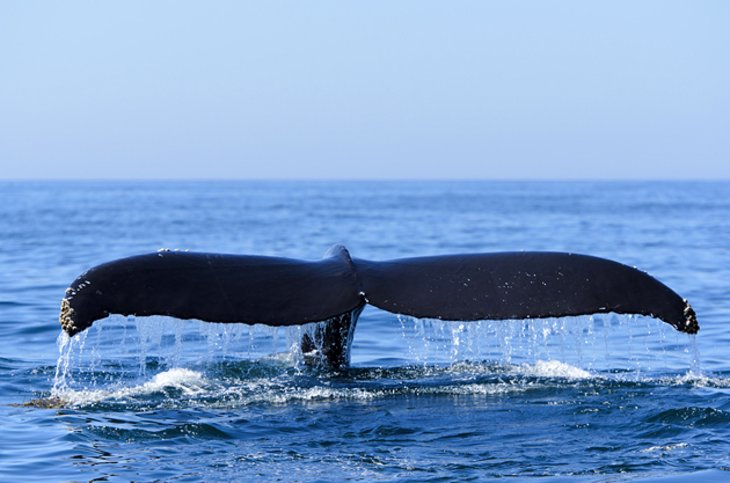
Many of the attractions that make New Brunswick and so appealing to tourists are directly related to the Bay of Fundy and its tides. The highest tides in the world, which can measure upwards to 19 meters (10 fathoms) deep, occur twice daily in this funnel-shaped bay, and over the millennia, these rushing waters accept carved a coastline marked by dramatic cliffs, sea caves, and fantastic rock formations.
Equally they rising and fall each day, the tides create natural phenomena that include Moncton'due south tidal bore and Saint John'south famous Reversing Falls. Forth the irregular shore, lighthouses crown the points, and picturesque fishing villages lie snug in its coves. The powerful tides also bring an enormous corporeality of plankton and fish into the bay, making it prime feeding waters for whales; as many as 12 species are found here in the summer.
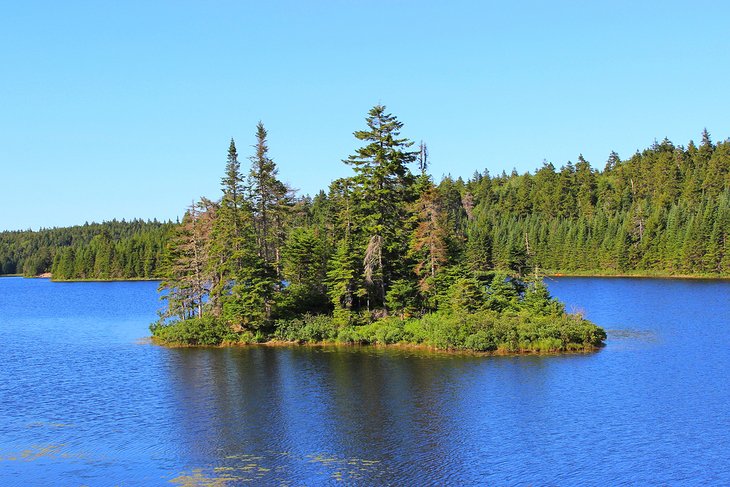
The New Brunswick forest meets the tides in Fundy National Park, a stretch of undeveloped coastline roughly midway between Moncton and Saint John. Visitors can enjoy this wilderness twelvemonth-round. Hiking trails lead along the declension and through the forests, and in the spring and autumn, birders come up to encounter migratory species feeding on the tidal mudflats.
One of the favorite things to practise in the wintertime is ski on the park's 40 kilometers of trails that are groomed for cross-country skiing. Three of the nearly beautiful waterfalls in New Brunswick are near Alma, a hamlet within the park: Dickson Falls; Laverty Falls; and Third Vault Falls, the tallest at 16 meters. Park facilities include campgrounds, swimming, and a golf course.
Official site: https://www.pc.gc.ca/pn-np/nb/fundy
Accommodation: Where to Stay near the Bay of Fundy
- Read More: Tiptop-Rated Tourist Attractions on the Bay of Fundy
ii. Hopewell Rocks
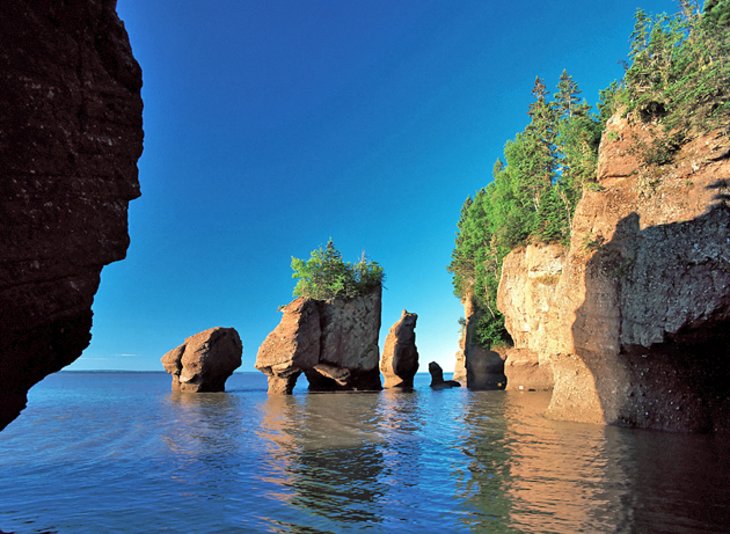
The Hopewell Rocks look quite different at high and depression tides. When the tide is in, they appear as tree-clad islands, which you tin view from a series of platforms connected by stairs. At low tide, they get behemothic, deeply eroded body of water stacks towering above a rocky embankment, and you tin descend the stairs to the ocean floor to walk amidst them.
Park rangers are hither to answer questions and to exist sure the beach is cleared before the tide comes rushing in. Interpretive signs and the visitor center displays explain the formation of these sculptured cliffs and pillars. At high tide, the best style to appreciate these rocks is to kayak among them on a guided kayak excursion with Baymount Outdoor Adventures.
Address: 131 Discovery Road, Hopewell Greatcoat, New Brunswick
Official site: http://www.thehopewellrocks.ca/
3. The Fundy Trail Parkway
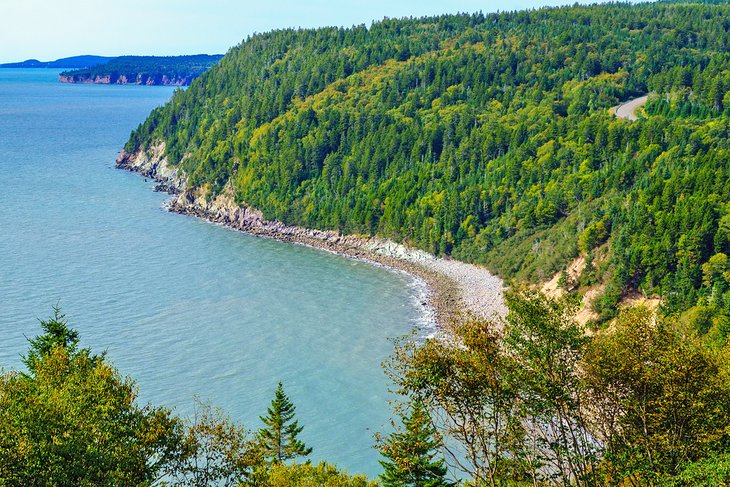
The Fundy Trail Parkway is a scenic coastal drive that lies northeast of Saint John. It starts near St. Martins, once a bustling shipbuilding community, and continues along the coast. It's a wearisome-paced road, where scenic lookouts and picnic areas provide views of coastal cliffs, isolated beaches, marine wild fauna, and a Flowerpot Rock.
A 10-kilometer pedestrian and bicycle trail parallels the drive, and some of the overlooks have trails to secluded cobble-strewn coves. The interpretive center at Big Salmon River has an interesting video and displays that fill in the background on the former logging customs here, and old lumbering equipment is displayed at the Heritage Sawmill.
Kids will like the nearby 84-meter (275-pes) suspension footbridge across Large Salmon River. A route also crosses the river, to climb the steep headland and proceed along the clifftops and down to a long embankment. Parking areas at the lookouts are served on weekends by a shuttle that returns walkers to their cars.
The Fundy Trail Parkway is accessed from the village of St. Martins, where you'll find two covered bridges, ocean caves accessible at low tide, craft shops and an outfitter for kayak tours of the caves and Fundy coast. St Martins and the parkway are an easy solar day trip from Saint John.
Address: 229 Chief Street, St. Martins
Official site: http://www.fundytrailparkway.com/
4. Whale Watching from St. Andrews-by-the-Sea
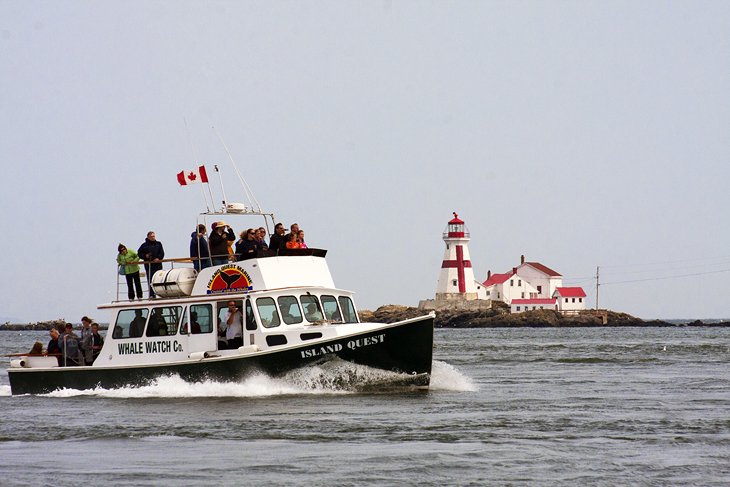
The Bay of Fundy attracts as many equally 12 species of whales and other marine animals, who gather hither in the summertime to have their young and to feed on the abundant krill and fish brought in by the Fundy tides. Minke and Finback wales arrive in the spring, along with Harbour Porpoises, followed by Humpback Whales and White-sided Dolphins in June.
By midsummer more than species have returned, including the rare Northward Atlantic Right Whale. So the flavour runs from June through October, with the highest concentration in August. The chances of seeing not simply a whale, but numerous whales and other wildlife are very high here, and on the way to the all-time sighting waters you'll savor cruising by lighthouses and islands where sea birds nest.
Three different companies in St Andrews -- Island Quest Marine Whale and Wild animals Cruises, Fundy Tide Runners and Jolly Breeze Alpine Ship -- offer a variety of whale watching experiences that range from zodiacs to a fully rigged sailing ship. Jolly Breeze is, with costumes and on-board activities, is peculiarly popular with younger children. All are located effectually the master dock off Water Street.
There are a lot more things to do in this pretty town: a replica of a blockhouse from the War of 1812, the Huntsman Marine Science Center, Kingsbrae Garden and streets of lovely historic homes, some of which we floated across the bay from Maine by Loyalists during the American Revolution.
Ministers Island Historic Site accessible but at low tide past causeway, is a fifty-room summer home that once belonged to visionary railway architect Sir William Van Horne, who also congenital the landmark St Andrews hotel, The Algonquin.
5. Roosevelt Campobello International Park
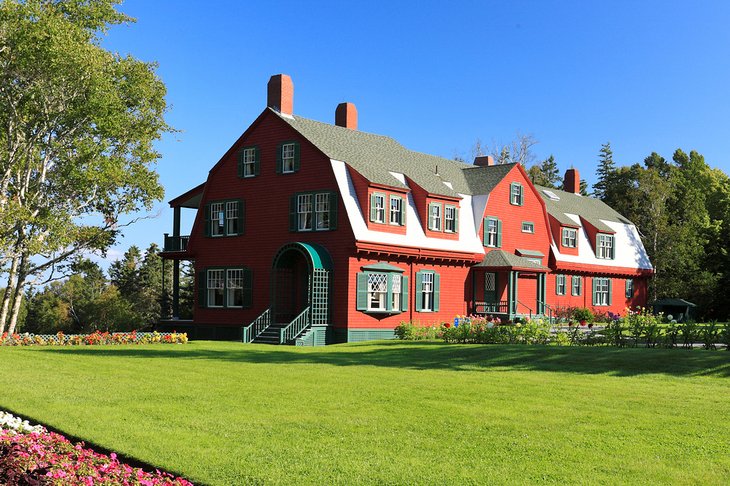
Campobello Island is accessible mid-June through September via ferries from mainland New Brunswick to Deer Island and on to Campobello, and by span year-round from Lubec, Maine. Though role of Canada, it has strong cross-border connections, including the historic Roosevelt summer estate that's the centerpiece of Roosevelt Campobello International Park.
The property'due south main construction is a 34-room cottage, where the Roosevelts summered with their children from 1905 until 1921. Franklin and his parents had summered on Campobello since he was a child. Many of the effects are original to the family unit, and well-informed guides offer details about the rooms and the Roosevelts during their stays here.
Visitors often remark on the servants' rooms, which are mixed with those of the family on the second floor, and are as large and well-furnished. Fifty-fifty though they had both grown up in aristocratic families, this was something both Eleanor and Franklin felt strongly about.
Along with the Roosevelt Cottage, at that place are several other summer homes on the extensive grounds overlooking the bay. In one of them, visitors can bring together the "Tea with Eleanor" programme, enjoying tea and cookies while staff members relate lively and personal stories about the quondam First Lady and her many activities and initiatives.
Option up the guide to wildflowers and plants in the park, or take a geological walking tour, a self-guided bog tour, or follow trails through the various ecosystems. Well-nigh the Roosevelt park, Herring Cove Provincial Park has camping, golf, hiking trails, and beaches, and at the northern tip of the island is Eastward Quoddy Lighthouse.
Address: 459 Route 774, Welshpool, New Brunswick
Official site: http://world wide web.fdr.net/
6. Reversing Falls, Skywalk, and Stonehammer Geopark
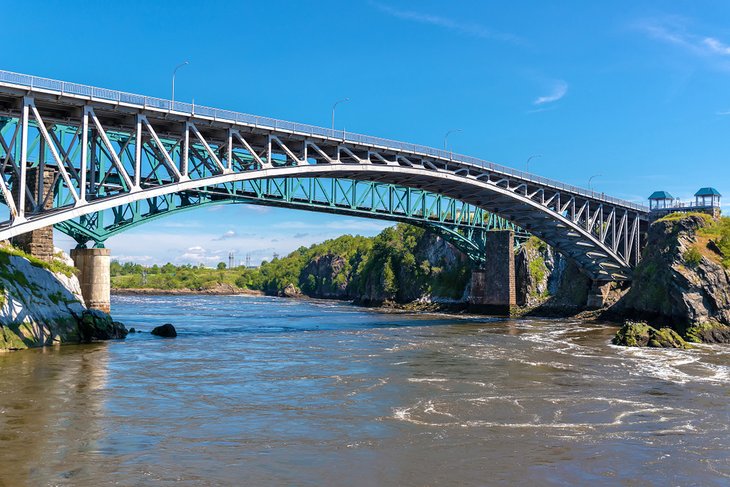
The Bay of Fundy has such an extreme tidal range that ocean level is four meters below the river at low tide, but 4 meters above the river at high tide. The tide rises so fast and and then powerfully that it forces water back into the oral fissure of the St. John River, causing it to flow backward.
As water rushes through the narrow gorge at the head of the harbor, it is forced over a ridge of stone, creating a waterfall that flows upstream. As the tide recedes 12 hours later, the river resumes its natural period, pushing h2o over the ridge to create a falls in the downstream direction.
The all-time views are at Reversing Falls Bridge, where the river narrows through a deep gorge, and at the new Skywalk Saint John, at the stop of the span. This rooftop observation platform extends more than than eight meters across the edge of the cliff higher up the falls, and glass flooring panels in the stainless-steel structure provide a clear view of the cliffs, falls, and whirlpools xxx meters beneath. Video and interactive displays explain the falls and the geology of the cliffs enclosing them.
Another viewpoint for the intense blitz of h2o is at the nearby Fallsview Park, home to the Stonehammer Geopark, the only UNESCO-listed global geopark in North America. Here, y'all'll find that in that location'south more than to see and do at the Reversing Falls than watch the force of the tides at work.
The walls of the gorge are a expert place to see where ane.2-billion-twelvemonth-old Precambrian marble from South America collided with 500-1000000-year-old igneous stone from the African plate, and to witness the work of glaciers every bit they carved the river's path. These and other phenomena are explored at the Stonehammer Geopark, where you can too take a boat ride into the gorge or zipline in a higher place the rushing waters.
Address: 200 Bridge Route, Saint John, New Brunswick
Official site: https://stonehammergeopark.com/feel/skywalk-saint-john/
7. Fredericton'due south Garrison Commune
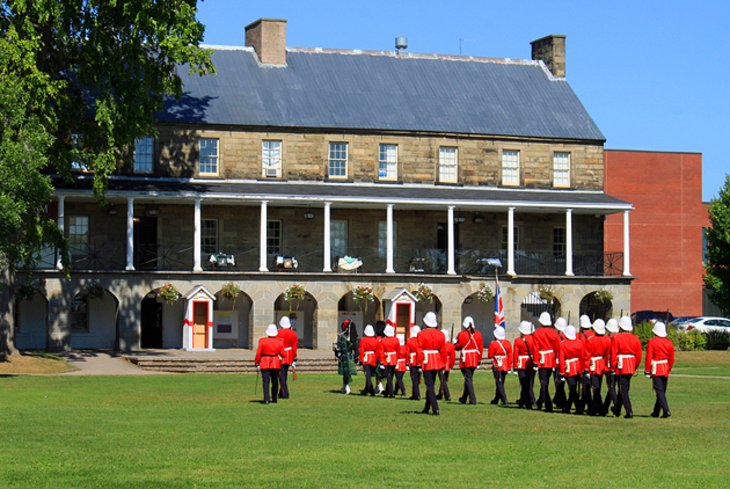
A British garrison was stationed at this site alongside the wide St. John River from 1784 to 1869. Today, two blocks of heritage buildings and grassy lawns lie between Queen Street and the river, becoming the middle of summertime festivals, walking tours, and historical reenactments.
The Changing of the Guard, when guards in period costume perform a drill ceremony to the accompaniment of drums and bagpipes, takes place 2 or three times daily in July and August. Children can don cherry uniforms of their own to accept part in "A Twenty-four hours in a Soldier's Life" activities, or families can play croquet together on the lawns. The Garrison District is the venue for several festivals, including the internationally known Harvest Jazz & Blues Festival each September.
Along with the garrison's Baby-sit Firm military office, prisoner cell cake, and restored Billet room, which you tin can visit, several museums are in the district. The Fredericton Region Museum focuses on area history (its near famous resident is a giant frog), and the Schoolhouse Days Museum shows menses classrooms, vesture, and artifacts, such as toys and lunchboxes.
The NB Sports Hall of Fame features sports heroes, and the New Brunswick College of Craft and Blueprint has a gallery showing the works of its talented students and graduates. Just down the main street is New Brunswick's premier art museum, Beaverbrook Art Gallery, with its new wing opened in 2017. A highlight of the new wing is Salvador Dali'due south monumental painting, Santiago el Grande.
Accost: Queen Street, Fredericton, New Brunswick
eight. Kingsbrae Garden
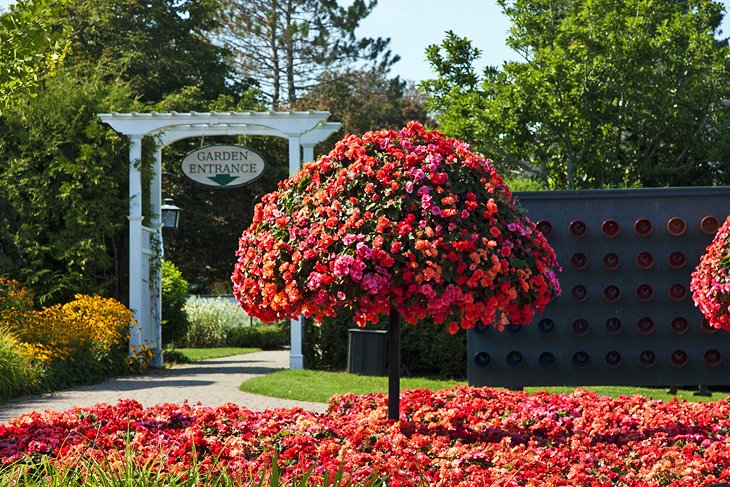
New Brunswick's premier botanical garden enjoys a climate tempered by the Bay of Fundy to abound more than than 50,000 perennials in a series of themed gardens. The floral displays are scenic, but beyond the gardens' beauty are the horticultural lessons it teaches about organic and sustainable practices, garden design, and how gardens fit into their landscapes and ecosystems.
As you stroll through the gardens, y'all'll find a windmill, 2 beautifully detailed historic playhouses, a cedar maze, peacocks, ponds, an apple orchard, woodland trails, a garden for the senses, a heather garden, and formal terraces. An unabridged section for children features small playhouses, a castle to climb, rabbits, and an side by side corral with alpacas and goats.
Works of gimmicky sculptors are placed throughout the gardens, and a divide Sculpture Garden showcases dozens more in settings designed for each 1. A tea room spreads onto a terrace overlooking the manicured lawns.
Address: 220 King Street, St. Andrews-by-the-Sea, New Brunswick
Official site: www.kingsbraegarden.com
9. Boyce Farmers Market
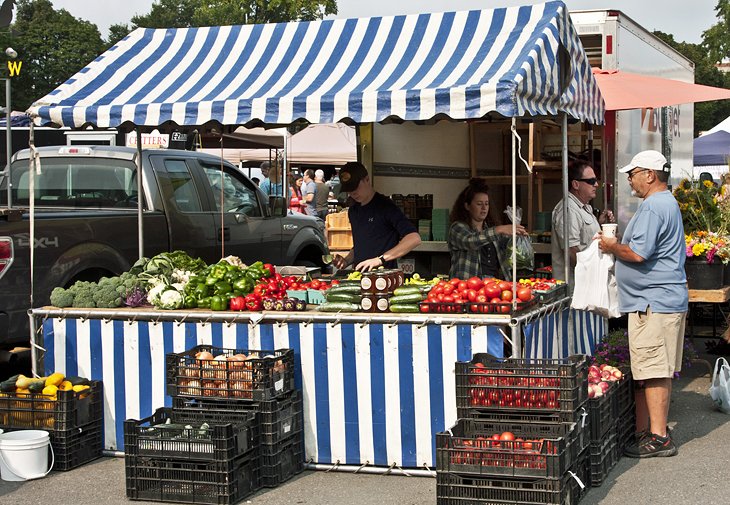
Each Saturday morn, a steady stream of Fredericton residents head to Boyce Farmers Market place, one of Canada's top ten community markets, and it'south worth some advance trip planning to bring together them hither. Spread over two large market place halls and the surrounding outdoor area are more than 250 local farmers, food producers, and craftspeople from along the St. John River region and beyond New Brunswick.
While locals conversation with neighbors and store for vegetables, meats, dairy products, and breads from several bakeries, tourists find wild blueberry jam; woods crafts; maple syrup; handmade soaps; hand-knit socks and mittens; stylish felted wool hats; pottery; jewelry; and ready-to-swallow foods of all kinds, from local cheeses and warm pretzels to samosas and sizzling grilled sausages.
Stand up in line for a sit-downward breakfast in the market or grab a croissant and java and caput for one of the picnic tables outside. Await here for bags of dulse, a traditional local seaweed snack.
Address: Brunswick Street, Fredericton, New Brunswick
Official site: http://frederictonfarmersmarket.ca/
ten. Historic Saint John
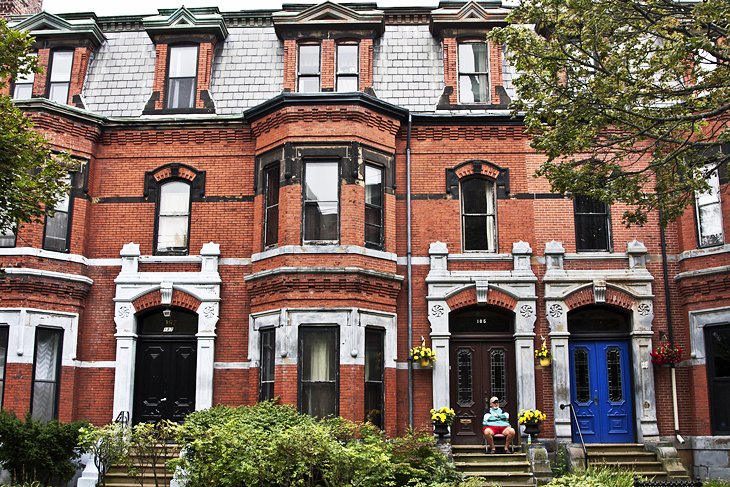
Prominent amongst the early settlers of Saint John were supporters of the British Crown, who arrived on 2 fleets of ships from Massachusetts, families escaping the American Revolution. These and subsequent Loyalists shaped the character of the city, as they did much of southern and central New Brunswick.
Perhaps even more influential in shaping the present appearance of the city's uptown commercial and residential district was the Cracking Burn of 1877, which completely destroyed more 21 entire streets. The buildings that rose from the ashes were all in the style of that period, leaving Saint John with some of Canada's best Victorian architecture.
Prince William Street is designated a National Historic Site of Canada for its rare concentration of distinguished buildings designed and busy in the styles of one period. Further up the hill are entire blocks of townhouses reminiscent of Boston's Dorsum Bay and Beacon Colina, not surprising, since many of the architects who came to help with the rebuilding were from Boston. You tin can explore these celebrated neighborhoods with downloadable maps and apps detailing the Loyalist Trail, the Victorian Stroll, and the Prince William Walk.
Ane of the few buildings to escape the burn was St. John'south Anglican Church, built in 1825 and a National Historic Site. Some other spared was the City Market, Canada'southward oldest continuing farmers' market, completed but the year earlier. The block-long building houses local vendors, who display fresh produce, seafood, and other edibles, too every bit crafts and fine art.
Fine handcrafts and art are highly valued in Saint John, every bit you will notice from the number of galleries and studios y'all'll pass. You can selection up a map of these from the visitors heart at Market Foursquare, which is filled with sidewalk cafes and inhabited by the colorful, larger-than-life people sculptured past John Hooper.
- Read More: Top-Rated Tourist Attractions in Saint John, New Brunswick
eleven. Grand Manan Island
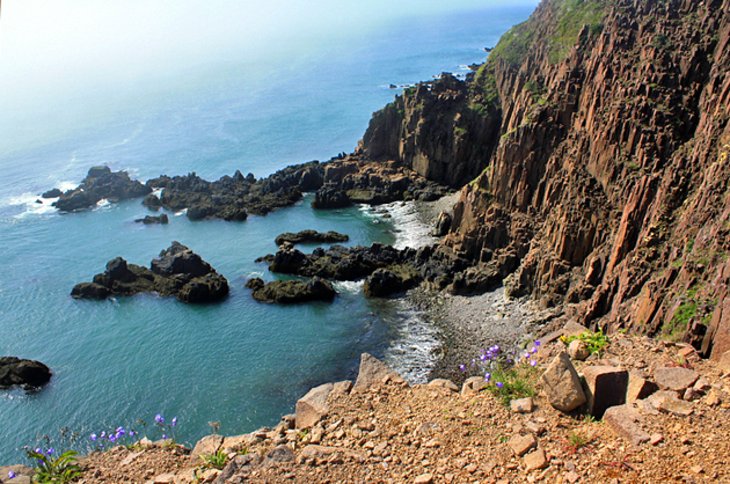
Attainable but by ferry from Blacks Harbour, the island of Yard Manan is a tiny fishing community near the oral cavity of the Bay of Fundy. A route follows the sea along its 35-kilometer length, with a few side roads leading the 10 kilometers to its precipitous western shore.
Birders come up to spot some of the more than than 240 species plant hither, including the Atlantic puffin, and the island is besides a popular base of operations for whale-watching and to spot other aquatic animals, including the Atlantic white-sided dolphin, harbor porpoise, and four species of seals. Artists notice inspiration in its rugged cliffs, lighthouses, and fishing villages, and you'll observe a number of studios and galleries on the isle.
12. Kings Landing
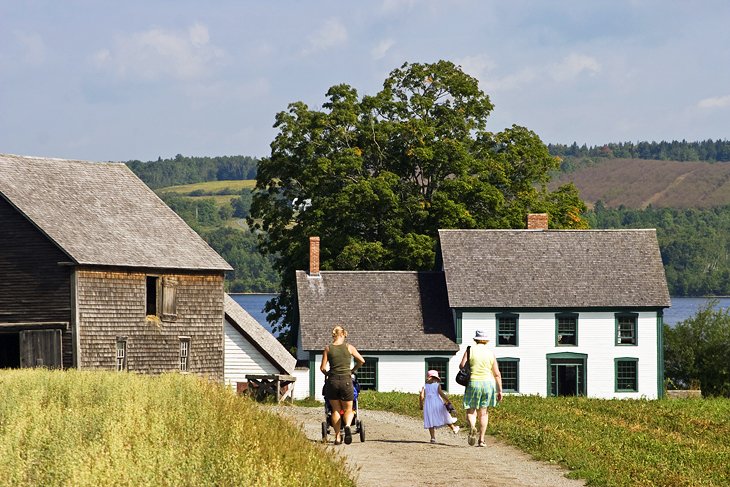
A unique combination of untraditional museum and historical hamlet experience, Kings Landing brings the history of rural New Brunswick to life for all ages. Begin a visit with the series of lively, interactive exhibits that draw from the collection of more than lxx,000 artifacts to lure visitors into the by.
Following various themes and including plenty of active experiences (maybe try on period clothes or play a vintage musical instrument), the exhibits prepare the historical stage for a catamenia that begins with the arrival of the Loyalists from the just-forming Us and ends with the technological advancements of the early on 20th century. Here, too, are complimentary workshops where you can learn 19th-century skills and crafts, such as embroidery or rope-making, or perhaps make your own candles.
Once you cross the span, you step into a country village of people going well-nigh their daily lives. Costumed interpreters may invite you to pitch in and help with household and kitchen tasks or disposed gardens, and they always have time to explain what they are doing and how it relates to their lives and work.
Stroll through the hamlet homes and farms, and catch a wagon ride to visit the printer, a blacksmith, and a working sawmill. Usa visitors may be surprised to learn as much about their own history as they exercise near Canada's.
Accost: 5804 Road 102, Prince William, New Brunswick
Official site: http://kingslanding.nb.ca
13. Village Historique Acadien
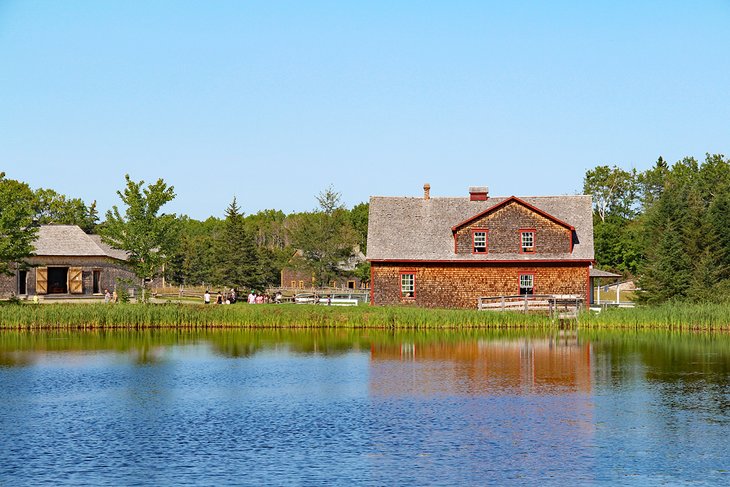
This museum village represents the lives of a different group of New Brunswick's settlers, the Acadians, who arrived from French republic in the 1600s and 1700s. Their French-speaking descendants live in northeastern New Brunswick, along the coast north of Moncton and throughout the region known as the Acadian Peninsula.
Village Historique Acadien represents the lives of Acadians betwixt 1780 and 1949, told through twoscore preserved and replicated homes, shops, and workshops. Costumed interpreters demonstrate the household, subcontract, and craftsmen'south skills that were establish in villages during those periods. Yous might arrive at a farmhouse kitchen in time for a few tips on early 19th-century cooking or to sense of taste bread fresh from the oven.
Elsewhere villagers are decorated with seasonal tasks: drying fish, carding and spinning wool, cut hay, forging tools and horse shoes. You can sample Acadian dishes in the restaurant and fifty-fifty stay overnight in an authentic hotel replicating an actual one that was operating in 1907 in nearby Caraquet. Known especially for its seafood, especially oysters (there's an oyster museum in town), Caraquet is a good base for exploring the Acadian Peninsula and beautiful Miscou Island.
Address: 14311 Road 11, Riviere du Nord, New Brunswick
Official site: https://villagehistoriqueacadien.com/en
14. Parlee Beach and Kouchibouguac National Park
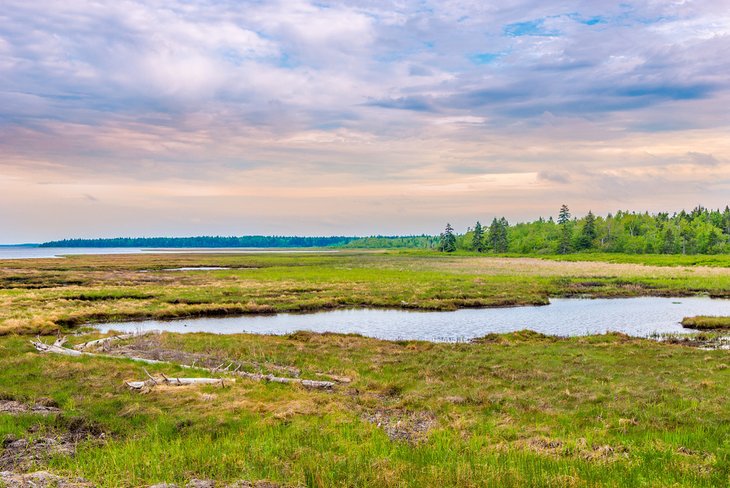
Fine sands and warm waters that can attain 20 degrees Celsius make the beaches along the Northumberland Strait, northward of Moncton, some of the finest on the Atlantic declension. Forth with its long white sands and gentle surf, Parlee Beach Provincial Park has a campground and changing facilities, catering to the many families that visit in summertime.
The nearby Acadian community of Shediac is known as the lobster upper-case letter of the world, and displays its pride with a double-decker-sized lobster statue almost the visitor information centre.
Farther north along this same coast, Kouchibouguac National Park includes a diverseness of ecosystems in add-on to its long, wide beaches and sandbars. These, plus tidal lagoons, high sand dunes, and salt marshes stretch along nearly thirty kilometers of shore, and forests extend inland. These habitats back up a diversity of plants, including more than 20 orchid species. Birdlife is only as rich, and you'll frequently see seals on the offshore sandbars. Along with campgrounds, public beaches, and picnic areas, canoe and bike rentals are available, every bit well equally snowshoes and ski equipment in the winter.
Address: 186 Route 117, Kouchibouguac National Park, New Brunswick
Official site: http://www.pc.gc.ca/en/pn-np/nb/kouchibouguac
xv. Magnetic Hill and Magnetic Hill Zoo
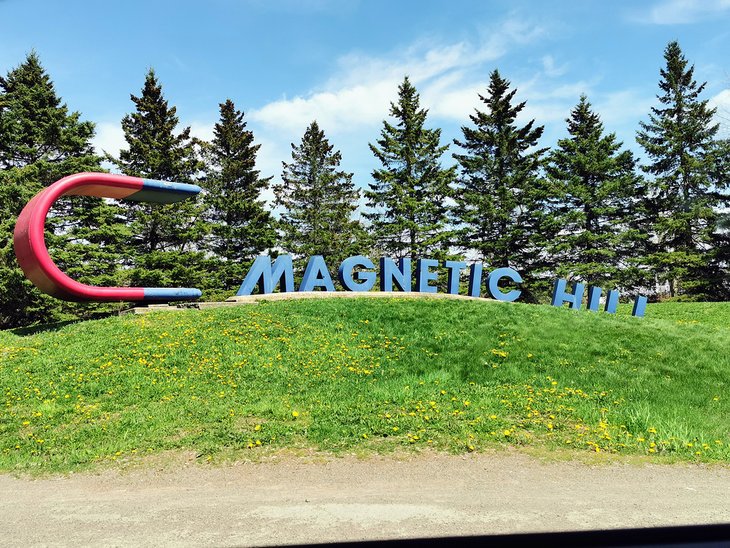
For generations of families visiting Moncton, Magnetic Hill has been a tourist icon, earning it a identify in the Canadian Register of Historic Places. Here, a car shifted into neutral with brakes released volition mysteriously move uphill. Of course, information technology doesn't really; it's an optical illusion acquired past the surrounding country's slope. The kids will dearest it.
They'll also dear the Magnetic Hill Zoo, 1 of the favorite things to do for families. The largest zoo in Atlantic Canada, Magnetic Loma houses about 600 mammals, birds, insects, reptiles, and fish. Specially popular are the big cats: African lions, jaguars, tigers, Amur leopards, cheetahs, and Amur tigers.
Other exotics are monkeys, toucans, flamingoes, zebras, ring-tailed lemurs, gibbons, and western cougars, simply just equally fascinating is the chance to observe difficult-to-spot local wildlife such as red foxes, otters, black bears, and caribou.
Address: 125 Magic Mountain Road, Moncton, New Brunswick
Official site: https://www.moncton.ca/magnetichillzoo
16. Cape Enrage
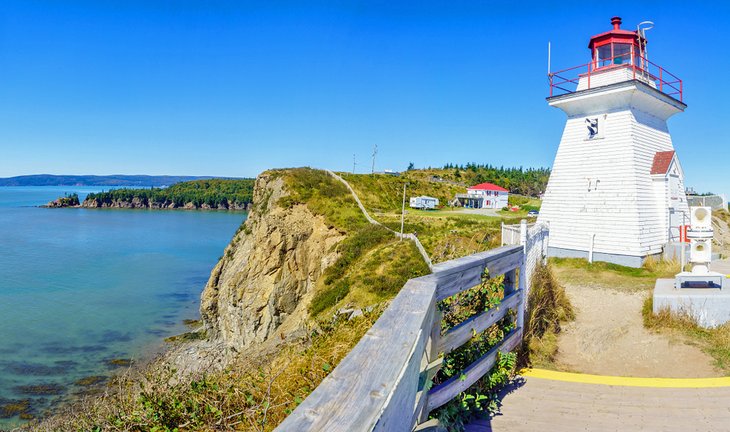
A tiny lighthouse dating to 1838 sits atop rugged cliffs at Greatcoat Enrage, providing a panoramic view over the Bay of Fundy. Though lite stations are fairly typical on the Atlantic Coast, Greatcoat Enrage as well has an outdoor activity eye, where enthusiasts can learn to rappel, zipline, rock climb, and kayak.
On a walk along Befouled Marsh Island Beach, condom only at low tide, you tin come across fossils that have fallen off the 40-meter cliffs that extend for four kilometers behind the beach. The fossils in the layers of sedimentary rock eroding from the cliff are most 320 million years former.
Address: 650 Cape Enrage Road, Waterside, New Brunswick
Official site: http://www.capeenrage.ca/
More Related Articles on PlanetWare.com
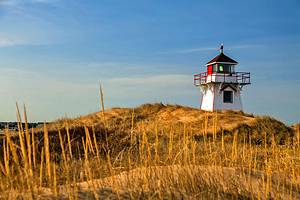 Where to Go from New Brunswick: Later on yous take explored the Bay of Fundy and New Brunswick'south cities, you'll want to cross over the Confederation Bridge to Prince Edward Island to explore its lively upper-case letter of Charlottetown, known equally the Birthplace of Canada.
Where to Go from New Brunswick: Later on yous take explored the Bay of Fundy and New Brunswick'south cities, you'll want to cross over the Confederation Bridge to Prince Edward Island to explore its lively upper-case letter of Charlottetown, known equally the Birthplace of Canada.
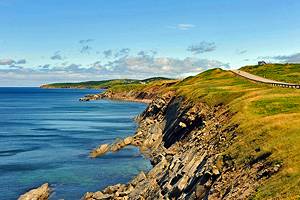 More Places to Visit in Atlantic Canada: You lot can take a ferry from Prince Edward Island to Nova Scotia, or you tin drive there from New Brunswick across a narrow isthmus near the Confederation Span. Y'all'll find enough of things to do in Nova Scotia: visit the lovely Annapolis Valley or drive the famed Cabot Trail to explore the beautiful highlands of Cape Breton Island.
More Places to Visit in Atlantic Canada: You lot can take a ferry from Prince Edward Island to Nova Scotia, or you tin drive there from New Brunswick across a narrow isthmus near the Confederation Span. Y'all'll find enough of things to do in Nova Scotia: visit the lovely Annapolis Valley or drive the famed Cabot Trail to explore the beautiful highlands of Cape Breton Island.
Source: https://www.planetware.com/tourist-attractions-/new-brunswick-cdn-nb-nb.htm
0 Response to "Relgious Buildings in Nova Scotia Arts and Entertainment in New Brunswick Canada"
Post a Comment